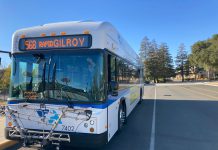The U.S. Fish and Wildlife opened a 16,000-square-foot visitor center and office in 2011, and it’s expected to double tourism dollars to the Los Banos area.
The San Luis National Wildlife Refuge Complex Headquarters and Visitors Center, built with $9.8 million of American Recovery and Reinvestment Act money secured in 2009, opened to the public in October after a blessing from representatives of the Southern Sierra Miwok Nation, the land’s original owners.
In 2010, more than 1.3 million people visited California refuges, and 100,000 visited the San Luis refuges. So, given the refuge’s proximity to major population centers in the Bay Area and elsewhere in the Valley, refuge staff conservatively estimates an average of 150,000 people to visit the center each year.
Each visitor to the refuge will spend an average of $62 locally and will generate about $11 in tax revenue, according to a 2007 report from the U.S. Fish and Wildlife Service’s Division of Economics, and so improves on the money brought in to local restaurants, hotels, gas stations and any other business that can cash in on tourism dollars.
The southern end of the center is roughly 5,000 square feet, with several displays of the wetlands’ native plants and animals — the riparian brush rabbit, riparian wood rat, San Joaquin kit fox, Fresno kangaroo rat, blunt-nosed leopard lizard and horned lizard, to name a few — each has something to grab, twist or push to make it interactive and appeal to children.
A life-sized bronze statue of a tule elk stands outside the main entrance, while the lobby sports a large window across the rear to serve as a place to view living tule elk.
The refuge is also home to hundreds of species of birds, including the migratory mallards, pintail and teal, and the perennial pheasant and quail.
The center is a less-than-zero energy consumer, meaning the building produces more energy than it consumes. The building also received a platinum-level Leadership in Energy and Environmental Design certification, an internationally recognized rating, based on standards for energy conservation, renewable energy production, water efficiency and others.
The Fish and Wildlife Service, now with its own building, expects to save $200,000 per year in office rental fees.
The complex represents California’s largest remaining collection of freshwater wetlands, including the 26,800-acre San Luis National Wildlife Refuge, the 10,200-acre Merced National Wildlife Refuge, the 7,000-acre San Joaquin River National Wildlife Refuge and the Grasslands Wildlife Management Area.
The refuge is at 7376 S. Wolfsen Road, off Highway 165, about six miles north of Highway 152.














